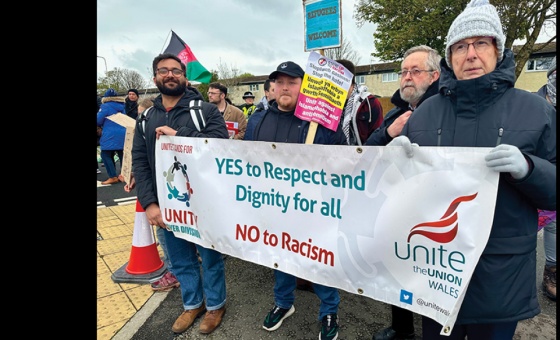This is the last article you can read this month
You can read more article this month
You can read more articles this month
Sorry your limit is up for this month
Reset on:
Please help support the Morning Star by subscribing here
THE right-wing media is full of bellicose Tories, including the Prime Minister, who say that Palestinian protests are “aggressive mobs” that are apparently threatening democracy. Yet more measures are planned to “crack down” on protest, except for ones that the Tories support such as farmers, of course.
Before she was sacked as home secretary, Suella Braverman said Palestinian protests were “hate marches” and protesters an “intimidating mob,” which is also what the reactionary thinker Edmund Burke said about the French revolution.
She then summoned up far-right groups who duly appeared and attacked police at the Cenotaph on Armistice Day. Meanwhile, crowds of many hundreds of thousands have continued to march peacefully calling for a ceasefire in Gaza in central London.
Historically speaking — not a phrase likely to be found on the lips of Braverman or Sunak — one person’s mob is another person’s crowd.
For example, protesting outside the house of someone who has transgressed many people’s understanding of what might be termed a “moral economy” is a British tradition stretching back over many centuries.
It was not, however, by any means always politically progressive, so the controversy over it is also something not recent. An anti-war crowd was to be found protesting outside President Joe Biden’s private house recently, reflecting deep tensions being caused by Gaza in the US.
As the great historian of 19th century protest, George Rude, underlined what reactionaries thought was a mob was in many cases simply a peaceful crowd making reasonable points. If one wants to look for a mob, the activities of the Bullingdon Club are a good place to start.
While Rude saw in protests, up to and including riots, the work of the crowd, with broadly progressive intentions and outcomes, EP Thompson was less happy with this formulation. He suggested that riots could also contain reactionary elements and the crowd involved in the Gordon Riots in 1780 would be an obvious example.
Thompson’s work on food riots points to the reality that the threat of a protest was often more effective than an actual riot. It could cause a reduction in the price of bread or the distribution of hoarded food. When riots did, quite rarely, occur, very much the same impact was to be found. Hidden food was seized and distributed at low prices.
There were other, more obviously political riots, often associated with the Chartists in the 1840s. The Chartists were an organised political force that most certainly did not support riots. It was rather the wider Chartist crowd that participated in such activities, often after provocation from the authorities.
There has been a lot more research and wider perspectives on the crowd since Thompson and Rude looked at the matter in the 1960s and ’70s. Crowds are viewed from the perspective of safety, risk management and psychology as well as history.
Historical research, however, can provide useful context by looking at who the individuals involved in mob or crowd protests were, what their intention was, how this turned out and what the reaction of authority was.
Such research is limited because often the only people who can be identified are those who are arrested and any who make public statements about their activities.
The democratic crowd will usually make it clear what it’s about so a lack of clarity may suggest a mob with less clear intent. The Palestinian protests in London and around Britain have made it perfectly obvious what they are about, even if Braverman, Sunak and co don’t like it. That’s democratic politics — something else Braverman and other Tories don’t like.
Keith Flett is a socialist historian. Follow him on X @kmflett.










